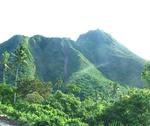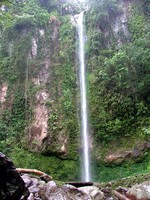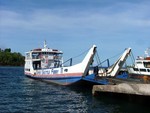Davao, 6 August 2009. My former boss, who comes from the United States had visited the secluded island several times. On the day I was leaving for South Africa for an international conference, my father was also embarking a trip to the place. I learned recently that my broadcast journalist friend also went to the island (I only learned about it when I saw the pictures he posted in his friendster account).
Sunrise in Camiguin.
The island I am referring to is Camiguin, which has been described as “Boracay 10 years ago.” So, when one of my colleagues told me that he was going to this remote, unspoiled paradise island, I asked him if I could go with the trip. He thought for few seconds before he finally consented to my request.
According to Governor Pedro P. Romualdo, the name “Camiguin” is derived from the native word kamagong, a tree of the Ebony family that thrives near Lake Mainit in Surigao del Norte. The original inhabitants of Camiguin were Manobos, who migrated from Surigao. The old native language in Camiguin is called “Kinamiguin,” which is similar to the dialect spoken in Surigao.
“Camiguin is an island of prime treats and primal threats.” That was what the brochure said of island-province, which is approximately 90 kilometers north of Cagayan de Oro City. In a way, that was I discovered during my recent visit to the island that was once part of Misamis Oriental.

Mt Hibok Hibok, the only active volcano among the seven found in Camiguin.
The province is literally “born of fire” as it has more volcanoes than municipalities. Camiguin has only five municipalities (Catarman, Guinisiliban, Mahinog, Mambajao, and Sagay) but it has seven volcanoes (Mount Vulcan Daan, Mount Mambajao, Mount Karling, Mount Uhay, Guinisiliban Peak, Tres Marias Mountain, and Mount Hibok-Hibok). Not surprisingly, though, it has earned the distinction of having the most number of volcanoes per square kilometer than any other island on earth (it has a total land area of 238 square kilometers).
Fortunately, only one volcano is considered active: Mount Hibok-Hibok (which means “that which heaves”). According to Filipino volcanologists, the said volcano constantly rumbled and smoke from 1948 to 1951. Some 79 people died when it erupted in 1949 due to landslides. Two years later, it erupted again. It unleashed boiling lava, poisonous gases, and landslides that destroyed nearly 19 squares kilometers of land particularly in Mambajao. All in all, over 3,000 people were killed.
There’s more to the island than volcanoes. Among locals, the place is known as “the island of your imagination.” As one tourism official explained: “Camiguin almost defies description. It is a tiny island of lush forests, volcanic splendor, eternal hot and cold natural springs, pristine patches of black and white beaches, majestic waterfalls, exotic marine life, blue-ridge mountains, serene surroundings, idyllic lifestyle; it has a glorious past, and is inhabited with jovial people. But the truth is, the province is best experienced than described as one gets enchanted by her mystical charm. It really has amazing natural resources and peaceful atmosphere that stir and baffle the minds of everyone.”
While traveling around the island, I was not surprised why the Tourism office identified Camiguin as one of the top 25 tourist destinations in the country. Indeed, it is a perfect package and a real ecological tourism destination.
Another must-see is the Katibawasan Falls, some five kilometers southeast of Mambajao at the foot of Mount Timpoong. Enclosed by a massive, fern-swathed, granite mountain wall, the waterfall is a sight to behold: a seemingly singular stream of water drops 50 meters from a bulging source without touching the granite wall. The falls tumble down into a green pool, ideal for a refreshing swim. Giant ferns decorate the surrounding land, carpeting for space with huge trees and dropping vines.

Majestic Katibawasan Falls.
Not to be missed also is the Ardent Hot Springs, a government-run resort located at the foot of still-active Mount Hibok-Hibok. The place has a four-tiered pool of varying depths and warmth. The ideal time for swimming is early morning or late afternoon. There are cottages, a restaurant, bar, coffee shop, and dormitory facilities provided for local and foreign tourists. The resort, with its lush vegetation, offers the serenity and restfulness of quiet and peaceful surroundings.
If history is your thing, there are several centuries-old churches found in various parts of the island. One of the famous churches is Sagay’s Sto. Rosario Church, which was built in 1882. A famous church located in Baylao is said to be miraculous during the volcanic eruption and claimed to have saved many lives.
Camiguin is known for two activities: Lanzones Festival and Panaad. Since it was during summer when I visited the island, I wasn’t able to witness these two events. But I was told that the Lanzones Festival – in honor of the tropical fruit that grows profusely in the island -- is celebrated every year in October with a weekend of street dancing, parade and pageants in the town of Mambajao. This festival includes an exhibit of agri-cottage industry products, barangay beautification, indigenous sports, tableau of local culture, and grand parade of the lanzones.
During Holy Week, religious devotees from all over Mindanao and the Visayas go around the island on foot for two days and nights as part of Panaad (literally means “promise”). They start walking the minute they step out of the ferry boat in the Benoni pier, going northwards through Mambajao, until they reach the Stations of the Cross on the slopes of Mount Vulcan Daan. In climbing up the mountain, they go through each of the life-size statues depicting the 14 stations of the crucifixion of Jesus Christ which are interspaced from each other.
Truly, Camiguin is a dream island. It is a place where you can simply revel in the marvels of nature without too many artificial distractions.
Yes, I will definitely revisit Camiguin!
Getting Around
The main mode of transportation in the island is the jeepney. You can ride one with other paying passengers going to a particular destination. Or you can rent one jeepney for a day at a hefty price, but that includes the driver’s services and gasoline, too.
Going around the island’s 64-kilometer circumferential road on a motorbike is sheer fun – and highly recommended by locals. Motorbikes may be rented at reasonable prices in the capital town of Mambajao.
Getting There

Benoni Port in Camiguin.
From Davao to Balingoan, Misamis Oriental, you take any of the hourly scheduled ferries (from 6AM to 5 PM) across the channels of Mindanao Sea, which dock in either ports of Guinsiliban or Benoni. If you take the Benoni port, travel time is about one hour.
Camiguin is also accessible by air and sea from Cebu City; but trips are limited only. Most fly in to Cagayan de Oro City, which is 84 km away from the port of Balingoan.
For those who would like to take their own vehicles to Camiguin, some of the ferryboats at Balingoan Port can transport cars, pick-ups, vans, and even large trucks to the Benoni Port.
